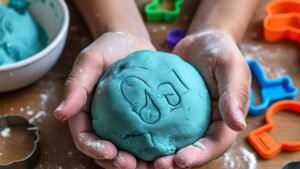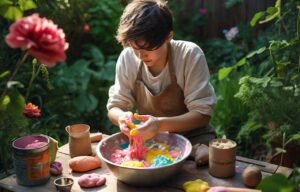This yummy and attractive material that kids are usually aware of is called Playdough; it is also used to help develop their creativity and accomplishment of their senses. Even though it is possible to buy playdough in stores, creating this by oneself is a great idea –available and relatively cheap. I will be explaining in detail a very basic and efficient recipe for homemade playdough that uses cream of tartar, an ingredient that is specifically important for improving texture and durability.
Explore Simple Cooking Recipes

WHY CREAM OF TARTAR?
Cream of tartar or potassium bitartrate, plays an important part in enhancing the elasticity of the playdough and additionally helps in not making the playdough sticky after several uses. It is also essential for the maintenance of bright colors, which are characteristic of play dough and other craft creations.
INGREDIENTS:
2 cups all-purpose flour: Frank is an essential ingredient to the playdough as it gives the basic framework to the playdough.
3/4 cup salt: Contributes a grainy feel and helps in preserving the food item.
4 teaspoons cream of tartar: Improve the elasticity and help to keep the consistency.
2 cups water: Mix well the ingredients and bring them together to get the mixture that you can use as the dough.
2 tablespoons vegetable oil: Serves the function of making it difficult for the dough to dry out.
Food coloring (optional): It enhances aesthetics and elements of design with creativity.
INSTRUCTIONS:
- Mix Dry Ingredients: For this recipe, in a large-sized pot bring together the floral, salt, and cream tartar and mix until these ingredients are well incorporated.
- Add Wet Ingredients: Add in the water and vegetable oil. Mix the ingredients well to distribute them also throughout the mixture.
- Cook Over Medium Heat: Put the pot on medium heat cook the mixture and stir continuously with a wooden spoon. The dough will start thickening and will combine with the other dough.
- Incorporate Food Coloring: If required to make it a particular color you can add a few drops of food coloring. Mix until it is uniformly mixed through the dough, and leave it to continue to stir for a while.
- Knead the Dough: knead for about 5 minutes, when the dough gathers itself in the center and pulls itself away from the sides of the pot then transfer it to a clean surface. Let it cool a little and then develop it until it becomes smooth and can be easily manipulated.
- Store Properly: Keep the playdough packed in an airtight bag or bin when not in use so that it does not dry up.
TIPS FOR SUCCESS:
- Consistency: Depending on the thickness of the sauce you prefer, tweak the cooking time a little bit. If they are cooked to the extent that most of the moisture has evaporated, they will become dry and tough; if cooked for a shorter time the dough will stick together.
- Color Variations: Try to mix the food coloring to come up with new colors that would make the children start to imagine.
- Safety: Children must be closely monitored when engaging in this activity especially while cooking, because the dough may become hot.

BENEFITS OF HOMEMADE PLAYDOUGH:
- Cost-Effective: In general, making playdough at your home is cost-effective when one needs to prepare a huge batch of desired colors.
- Customization: Adjust the materials’ texture, color, and/or smell of the playdough to individual or specific activities to be developed.
- Educational Value: In the case of baking, provide children with opportunities to measure, to mix, and to knead, to practice addition, such as, for instance, how many spoons of sugar with how many spoons of flour, and finally to learn sensory messages through touch.
SENSORY ALPHABET EXPLORATION:
After rolling these clay shapes into flat discs, one can use cookie cutters or letter stamps to obtain forms of the alphabet.
Motivate children to recognize and shape the letters and make them read and construct words.
MATH MANIPULATIVES:
Take a small quantity of the play dough and roll it into a ball, cube, cylinder, and so on.
These shapes can be used in number sense activities such as counting, sorting, and number problems as well as addition and subtraction.
NATURE IMPRESSIONS:
- Children can even be suggested to take the playdough outside, where they can strongly press the natural materials such as the leaves, flowers, and twigs into the playdough and observe how they are formed on the surfaces.
- Talk about various surfaces and formations as a way to make artistic and inspiring artwork.
- Miniature Sculptures:
- Engage the children in modeling the playdough into small replicas of large structures or animals or dwarfs of imaginary beasts.
- Promote imagination and narrative by suggesting to them that they should tell or explain stories behind the art creations.

THEMED PLAY SCENES:
This is done by kneading a playdough of different colors and molding it in forms that are convenient for a specific play scene for example undersea adventure, outer space, farm, etc.
Introduce toys and figurines that are small in size for added child fantasy and creativity in role-playing.
TEXTURE EXPLORATION:
- Introduce end numbers of different consistencies by mixing objects into the playdough such as sand, rice, or lentils.
- Describe how things feel and look, which aids in the establishment of the children’s sensitivity to their surroundings as well as the development of an extensive vocabulary.
PLAYDOUGH PUZZLES:
- Knead playdough into various colors and make long snakes and with the aid of a flat surface, develop simple puzzles or mazes on it.
- You can dare children to run their fingers or other small objects through the puzzle so that they can be able to go through it comfortably without coming out of the puzzle.
EMOTION FACES:
To make basic ideas about feelings children have to sculpt the main features of faces from playdough as eyes, a nose, and a mouth, and then depict various face expressions to express those emotions.
Introduce the topic of feeling and any other related emotion, and while playing focus on the different aspects of faces.
SCIENCE EXPERIMENTS:
- To teach basic scientific concepts such as sinking and floating, color mixing, or using LED lights simply make a playdough area where the children are free to play and to experiment with given materials.
- Introduce the concept of science and scientific method in an engaging, interactive, and fun way.
COLLABORATIVE ARTWORK:
- Prepare a big surface (for instance, poster board, tabletop) and ask the children to mix play-dough together and together create a large artwork with it.
- Allow many students to work in groups, think, and develop ideas and strategies when creating artwork as a team.
- These concepts not only enhance play with playdough but also assist in enhancing learning in multiple domains such as the motor, creative, cognitive, and social-emotional domains. Try these ideas to extend learning how you can make playtime more enjoyable with homemade play dough.
You May Also Like Latest Middle Names for Handsome Boys

CONCLUSION :
Hence, making homemade playdough with cream of tartar is one way of entertaining the family and teaching the children at the same time. By using such a simple recipe and adding your ideas you can help the little ones develop their imagination and at the same time fine motor skills. Have fun making and creating your colorful playdough toys!
You May Also Like the Latest Korean Boy Names










